Russel Brothers Limited OWEN SOUND, ONTARIO Steelcraft Boat Builders
| Radium Cruiser
Canadian List of Shipping 1956: Radium Express [C.171801] registered at Vancouver; built at Owen Sound 1939. Dimensions: 49'7 x 13' x 3'8; 27 g.t.; 8 n.t.; 100 hp. Owned by Northern Transportation Co. Ltd., Edmonton, Alberta. Canadian List of Shipping 1970: Steel tug Radium Express [C.171801] registered at Vancouver. Built at Owen Sound 1939. 50'; 27 g.t. Canadian List of Ships 1997: Not listed.
"Canada's publicly owned Northern Transporatation Company operates a rugged service. Since the channels encountered in the Athabasca, Slave, MacKenzie and Great Bear rivers are sometimes only three feet or a little more in depth, all the Radium line vessels are of shallow draught.They are built to push heavy barge loads of freight." Saskatoon Star-Phoenix - Sep 9, 1948 |
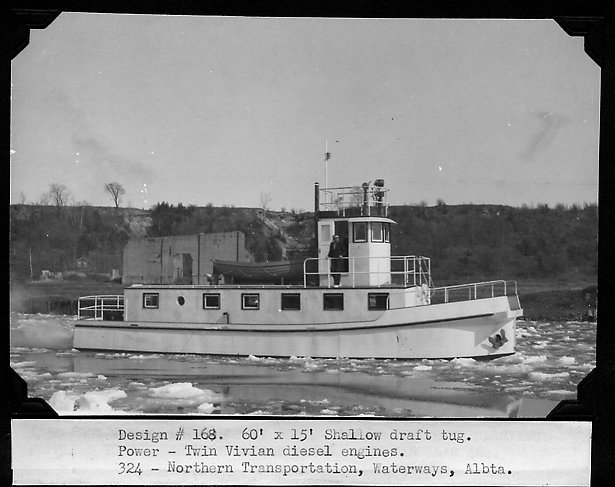
|
From the Company Brochure
"Steelcraft Hydraulic Steering Gears"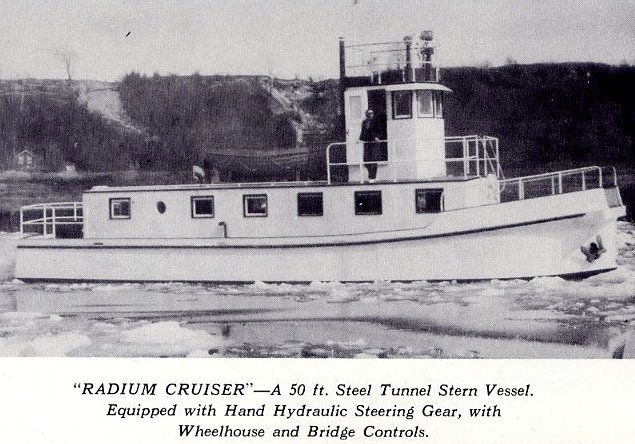 |
From the Company Brochure
"Steelcraft Powerful Diesel Tugs"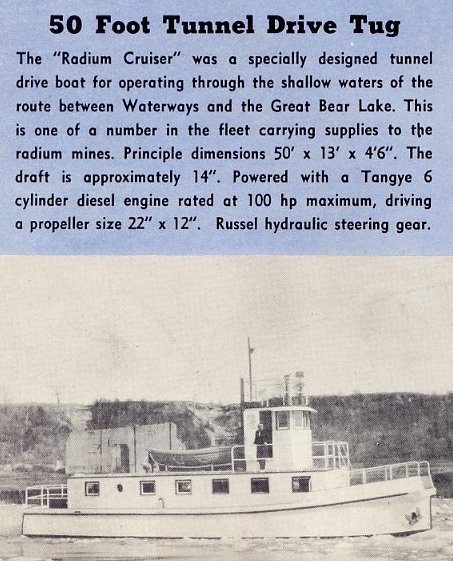 |
 |
Victoria Times Colonist, Mon. Mar. 17, 1939
clipping courtesy Leigh Cossey, Jan. 27, 2020.RADIUM FLEET IS INCREASED - Two Diesel Tugs Are Added to Sub-Arctic Shipping Routes Modernization of Canada's sub-Arctic shipping routes and ships has made more progress since the discovery of radium at El-dorado, Great Bear Lake, than during the half-century preceding, and two more of the thick-skinned steel tugs of the radium fleet, famed through the north as being able to navigate "in a heavy dew," are now under construction in Owen Sound, Ont.
Ordered for Northern Transportation Company Limited, they are the Radium Express and Radium Cruiser, both to be diesel driven with a draft of a few inches only, tunnel type, twin screw and, respectively, 60 and 50 feet in length.They will be shipped by rail to the end of steel for launching and will have engines and other equipment installed there. They will go into service on the Athabaska and Bear Rivers.
Two years ago, the Radium Queen and Radium King, built at Sorel, Quebec, were shipped in sections, were welded together again in sub-Arctic shipyards and launched thousands of miles from the spot where they were built. They were the first of the modern vessels. Modern tanker-barges for fuel oil and and other smaller ships have since been added. In the case of Northern Transportation, these vessels operate over 2,500 miles of freshwater routes in the sub-Arctic and Arctic, starting from Waterways, Alta., and going as far as the mouth of the Mackenzie River.
|
Owen Sound Sun Times. 1939 article features R.J. Foote, Radium Express, and Radium Cruiser.
Gerry Ouderkirk archive.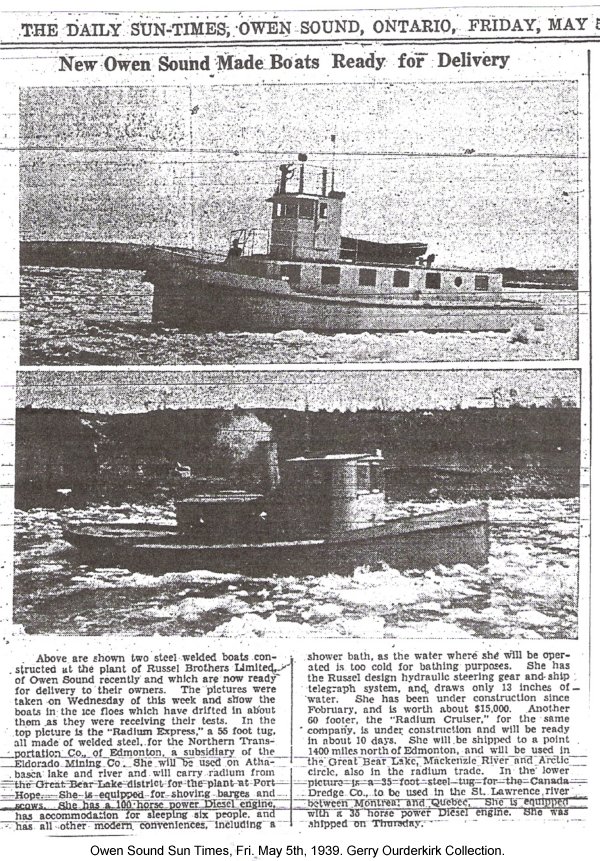
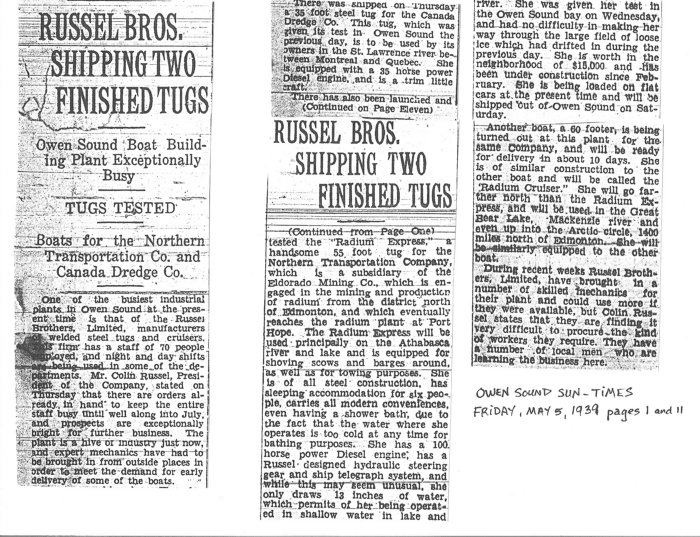 |
Montreal Gazette, April 12, 1939..."Both of the additions to the sub-arctic fleet will be capable of operating in extremely shallow water and hulls will be of extra-heavy steel construction. The 60 foot "Radium Express" twin screw, tunnel-type, will go into service this spring on the Bear River section of the 2500 mile freshwater route over which Northern operates. The new "Radium Cruiser", slightly smaller and of similar type, will operate on the Athabaska from Waterways."
https://news.google.com/newspapers?nid=1946&dat=19390412&id=EZgtAAAAIBAJ&sjid=wJgFAAAAIBAJ&pg=2902,2047114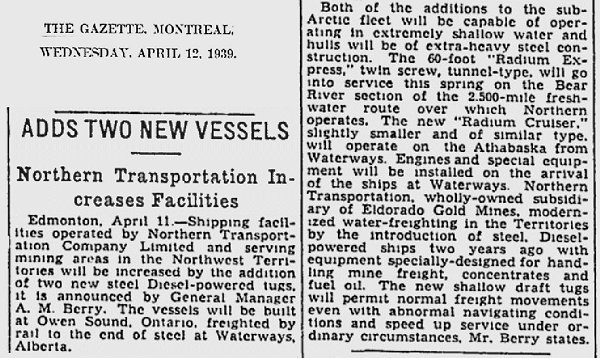 |
Launching the Radium Cruiser at Waterways, AB, 1939.
https://en.wikipedia.org/wiki/Radium_Cruiser
The Radium Cruiser was a tugboat operated on the Mackenzie River system for the "Radium Line". She was constructed in Owen Sound, Ontario, in 1939, then disassembled and shipped by rail to Waterways, Alberta. Waterways is a river port, and was then the northern terminus of the North American railway grid. Waterways is on the Clearwater River, not far upstream from where the river empties into Lake Athabasca. The waters of Lake Athabasca flow into Great Slave Lake down the Slave River, and then down the Mackenzie River to the Arctic Ocean.
A 16 mile series of large rapids at Fort Smith, NWT, on the Slave River, required a long portage. Most of the vessels of the Radium Line were reassembled at Waterways, sailed to Fort Smith, then portaged overland to the lower river, and where they could navigate most of the tributaries of the Mackenzie River, and reach the Arctic Ocean without further portages. The Radium Cruiser, like the earlier Radium Queen, was intended to move cargo from the railhead to the Fort Smith portage, and to navigate the Athabasca River, Clearwater River, Peace River and Lake Athabasca and her tributaries.
Ice prevents navigation of the Mackenzie River for almost eight months of the year.
Like her sister ship, Radium Express, she was smaller than the Radium King and Radium Queen, just 60 feet (18 m) long.
In 2005 Atomic Energy of Canada published a study of the toxic legacy of the mining of radioactive ore at Port Radium. According to the report all but one of the surviving vessels of the Radium line were found to be free of contamination, with the exception of the Radium Gilbert, but the disposition of the Radium Cruiser was not known.
Radium Cruiser in the NWT Archives. Left: ? Father M. Beauregard, Norman Wells on Mackenzie River [boat Radium Cruiser], 1943-47. Right: 'Radium Cruiser' at Norman Wells and short-billed gulls, July 11, 1949.
https://www.nwtarchives.ca/item_results.asp?TrackID=717173
Radium Cruiser on Slave River at Bell Rock, 1960. Photos by Povl Nurnberger.
https://flickr.com/photos/povl2009/5068005876
For more Russel exhibits visit Owen Sound Marine & Rail Museum 1165 1st Ave West, Owen Sound, ON N4K 4K8
(519) 371-3333  http://marinerail.com http://marinerail.com |
|
|
|
|
|